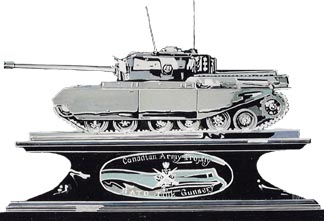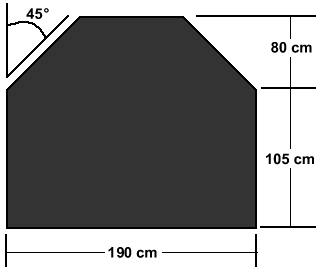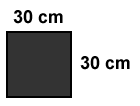|
|
CANADIAN ARMY TROPHY 1987 SCORING & RULES |
| |

Scoring:
- Main gun:
- Hit Score = (Total target hits x 100) x 100
Total targets
- Time Score = Total hit time + (40 sec) x (misses) x 100
Total targets x max exposure time
- Hit bonus = 500 points for hits on all targets
(only if all main gun targets are hit)
- Ammunition bonus = (Rounds Remaining) x 100 x 40
Total rounds
(only if all main gun targets are hit)
- Machine gun:
- Hit Score = Targets Hit x 100 x 20
Total Targets
- Penalties:
- 600 Points -not arriving on bound in time
- 1000 pts./rnd. -unauthorized use of reserve ammo
Maximum Possible Scores for CAT Battle Run |
|
Component Score |
Points |
|
Hit Score |
10,000 |
Time Score |
8,500 |
Hit Bonus |
500 |
Ammunition Bonus |
1,600 |
Machinegun Score |
2,000 |
|
Total Score |
22,600 |
Ammunition:
- Each tank is to stow 10 target practice rounds
for the main armament and 250 rounds of machine gun ammunition.
- A reserve of four main gun rounds and 125 machine gun rounds will
also be carried, but used only at the specific direction of a judge.
Targets:
- Targets will be in a configuration as shown below.
- They will be painted a dark color and heated. There will be heated
decoys on the course.
Main Gun

Machine Gun

Rules and Conditions:
Preparations began early in 1986 with the formulation of the
CAT '87 Rules and Conditions. The major rules and conditions that
governed the preparation for and the conduct of CAT '87 had special
significance for those who were organizing and preparing a competitor.
- Canadian Army Trophy Committee of Control (CATCC):
- The presence of all CATCC members or authorized
representatives is required to hold a meeting. Committee decided all
rules and conditions--and all changes.
- At least 70% (9 of 12) members must agree on any decision.
Only one of these members was American.
- Competition:
- Competition between tank platoons from NORTHAG and tank
platoons from CENTAG is as follows:
NORTHAG |
CENTAG |
I (Belgian) Corps 2 Platoons |
II (German) Corps 2 Platoons |
I (British ) Corps 3 Platoons |
III (German) Corps 2 Platoons |
I (German) Corps 2 Platoons |
V (U.S.) Corps 3 Platoons |
2 AD (Fwd) (U.S.) 3 Platoons |
VII (U.S.) Corps 3 Platoons |
I (Dutch) Corps 2 Platoons |
4 CMBG (Canadian) 2 Platoons |
5 Companies/12 Platoons |
5 Companies/12 Platoons |
- At least 70% (9 of 12) members must agree on any decision. Only one of these members was American.
- Each platoon organizes with its organic number of tanks.
This was a change from the past and was urged by the U.S.
- The host army group (CENTAG) informs HQ AFCENT of the
competition range selection not later than 1 January 1987.
- The competition range is out of bounds to all companies in
the random selection pool from 1 January until the competition.
- Team Selection Criteria:
- Random selection pool. Each Army Group Corps designates
minimum of one company from two different battalions; each separate
brigade designates a minimum of two companies. The U.S. urged
the random concept in an attempt to overcome a perceived advantage
gained in the past by some countries that pooled and concentrated
especially skilled tankers.
- The formation of special companies and/or alteration of national
personnel assignment policies for the competition is prohibited.
The limits of this rule were liberally interpreted.
- Headquarters AFCENT makes a random selection of the tank
companies to compete no later than 1 April 1987.
- Tank commanders and gunners may not compete in successive
CATs in the same duty position as the preceding CAT.
Exceptions may be made, for example, as in the case of a 1985 tank
commander promoted to Platoon Sergeant. The U.S. had lobbied for a
provision like this to break up alleged "professional CAT teams" of
some allies. It had some adverse impact on 2-66 Armor as it filled
out its required two tank companies for the random selection pool.
- Company rosters (by crew position) for all companies in the
pool must be submitted by 27 March 1987. Only those on this
roster will be permitted to compete in June.
- Other Key Rules:
- Total main armament ammunition expenditure for designated
tank companies is not to exceed 134 rounds per crew from 1
October 1986 to the competition.
- Main gun zeroing procedures must be done according to national
procedures.
- Headquarters AFCENT makes a random selection of the tank
companies to compete no later than 1 April 1987.
- Battle Run description and conduct:
- Every CAT platoon battle run is supervised by the Chief Judge.
However, the national judge of the army of the firing platoon issues
all instructions to the platoon leader during the battle run.
- Main Gun. The scenarios, planned by the Chief Judge, will include
a minimum of 18 or 24 targets and a maximum of 27 or 36
targets depending on the number of tanks in a platoon; however, the
total number of targets will be the same for each similar sized platoon
(the British had three-tank platoons; all others had four-tank
platoons). The Chief Judge will advise Team Captains of the total
number of targets (the decision was 24 and 32, respectively) the day
prior to the competition. The targets will be static or moving (up to
about 20 mph). The movers may be head-on, oblique or broad side.
Without knowing the exact number of targets, there was little option
but to train against the maximum.
- Machine gun. The scenarios are two groups of 10 targets
(falling metal plates) per firing lane (total of 20 targets per tank).
These targets will be engaged while on the move between bounds.
- All targets may be engaged by one or more tanks within the
platoon.
- Each main gun engagement will be comprised of two to eight
targets at various ranges. Main gun targets need not be visible to
each tank within a platoon except on the last bound where all main
gun targets are to be visible to each tank.
- There will be a minimum of 12 different target scenarios
and two spare scenarios for reruns. In selecting the scenarios, the
Chief Judge will draw them by lot on the evening of the preceding
day at the earliest. Each scenario must include as a minimum:
- Stationary Firing Tanks: Five main gun engagements including
(1) two engagements with both static and moving targets, and (2)
one engagement with six/eight targets depending on platoon size.
- Moving Firing Tanks: Two main gun engagements must be
while on the move against both moving and static targets.
|
- During a move, all targets must be engaged while moving.
- The time allowed for each move between bounds will average
about 10 mph.
- Main gun targets will be exposed for 40 seconds. Their
presentation may be staggered in time. This was new for CAT '87
and substantially increased the degree of difficulty. It was also more
in line with combat conditions.
- All target hits will be spotted and timed by an individual
observer. All hits are verified by a physical hole count (or a downed
plate in the case of machine gun targets.
- About two hours before its battle run the platoon occupies the
calibration range and is allowed one hour to zero its tank weapons.
- Upon the completion of zeroing, the platoon moves to
a waiting area until called forward by the national judge. On the
orders "MOVE TO BOUND ONE" and "CARRY OUT ACTION," the platoon
leader dashes the platoon along a trail
past the spectator stands--full of soldiers, families, and contractors
waving unit and national colors. The platoon's favorite recording
blares out over the
loud speaker system. Upon arrival at Bound One, the platoon has two
minutes to prepare the weapon systems to fire. The platoon leader
transmits "READY" in precisely two minutes.
- The national judge commands, "WATCH YOUR FRONT." The
tank commanders and gunners scan their SOP-designated sectors
with an uncommon concentration. There is a delay as the computer
activates the proper targets. Then, over the platoon radio
net,"TARGETS UP" initiates the platoon's target acquisition and fire
distribution system. The platoon gunners "kill" the target array within the 40 seconds that are available.
- Concise crew reports are transmitted to the platoon leader to account
for all targets, target hits, and ammunition fired.
- When the scenario calls for no more targets to be presented, all
targets are lowered. The national judge commands, "YOUR FRONT IS
CLEAR.
|
| |
|
| |
|
|